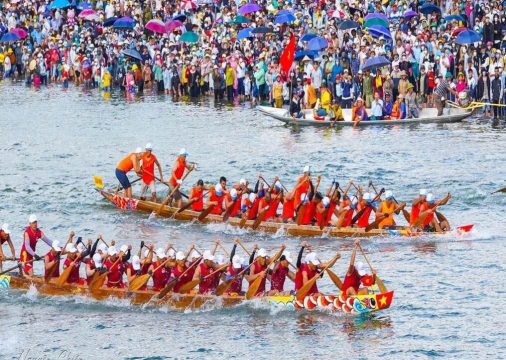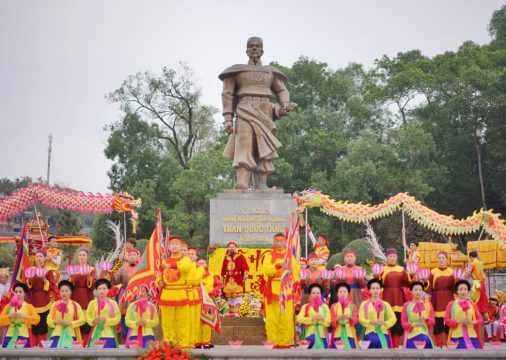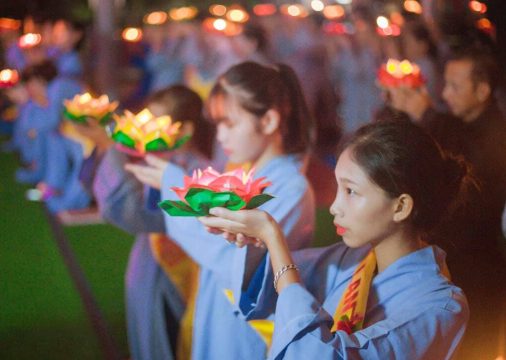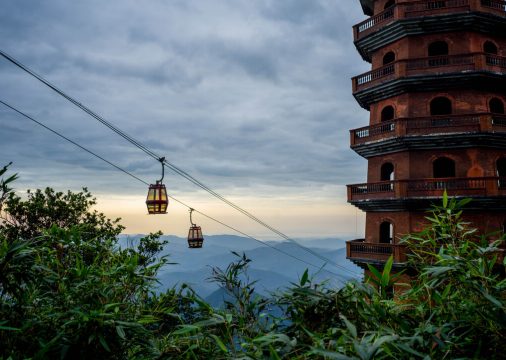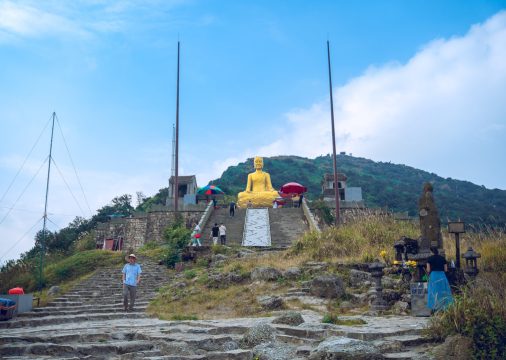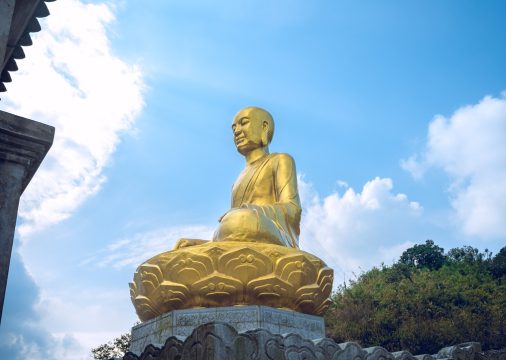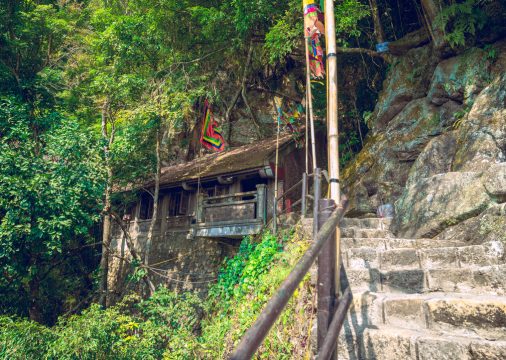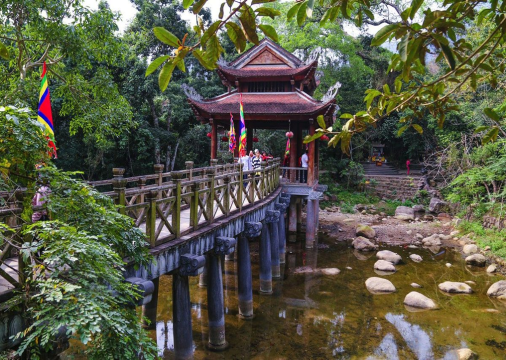Exploring Truc Lam Yen Tu Zen school: History, Features, and Influence
Truc Lam Yen Tu Zen school is a purely Vietnamese Zen lineage founded by King-Buddha Tran Nhan Tong in the 13th century, which has become an important spiritual and cultural symbol in the history of Vietnamese Buddhism. Join Yen Tu Tung Lam to learn about the origin, characteristics, and influence of this unique Zen school in the following article.
1. What is Truc Lam Yen Tu Zen school? Who was its founder?
This Zen lineage is a typical representation of the development of Vietnamese Buddhism during the Tran dynasty, harmoniously combining Buddhist philosophy and national cultural identity.
1.1. Definition and overview
Truc Lam Yen Tu Zen school is a purely Vietnamese Zen lineage, clearly reflecting the engaged spirit of Vietnamese Buddhism. This Zen school is characterized by the combination of spiritual practice and responsibility towards the nation, not separating religion from life, helping practitioners of Zen to both develop spiritually and fulfill their civic duties.
1.2. The founder: King-Buddha Tran Nhan Tong
Vua Tran Nhan Tong (1258-1308) was the founder of Truc Lam Yen Tu Zen school. As the eldest son of Vua Tran Thanh Tong and Nguyen Thanh Hoang hau, he ascended the throne in 1279. In addition to managing state affairs, he spent much time studying Buddhist scriptures and often invited high-ranking monks to the palace for consultation.
After abdicating, in 1299, he officially became a monk and went to practice at nui Yen Tu (Quang Ninh), taking the dharma name Huong Van Dai Dau Da. From here, he founded Truc Lam Zen school, revered by his contemporaries as King-Buddha or Dieu Ngu Giac Hoang.

1.3. Meaning of the name “Truc Lam” and its connection to nui Yen Tu
“Truc Lam” was originally the dharma name of Vua Tran Nhan Tong. This name signifies a serene place for practice, where lush bamboo forests thrive. Nui Yen Tu became the center of Truc Lam Zen school because it was where King-Buddha Tran Nhan Tong practiced, taught, and built many Buddhist establishments. The combination of “Truc Lam” and “Yen Tu” created the full name of the Zen school, reflecting both its origin and center of activity.
2. History of Formation and Development of Truc Lam Yen Tu Zen school
Truc Lam Yen Tu Zen school has a history of formation and development closely tied to the era of the Tran dynasty, a flourishing period for Vietnamese Buddhism. From its inception to its decline, this Zen school underwent many significant transformations, contributing to shaping the landscape of Vietnamese Buddhism.
2.1. Historical context of the Tran Dynasty
The Tran dynasty was a period of brilliant development for Vietnamese Buddhism. After expelling the Mong Nguyen invaders, the Tran court needed to build a national culture and ideology strong enough to free itself from foreign ideological dependence. Buddhism was chosen as the spiritual foundation in the construction and defense of the country.
Before Truc Lam Zen school was established, Vietnamese Buddhism had three main Zen schools: Ty Ni Da Luu Chi, Vo Ngon Thong, and Thao Duong. Under the influence of Vua Tran Thai Tong and Tue Trung Thuong Si, these three Zen schools gradually merged, paving the way for the emergence of a unified Zen school with a strong Vietnamese identity.
2.2. Period of strong development under the King-Buddha
When Tran Nhan Tong became a monk and founded Truc Lam Zen school in 1299, he unified the preceding Zen schools and the entire Buddhist Sangha of the Tran dynasty. This Zen school harmoniously combined elements of traditional Zen such as Ty Ni Da Luu Chi, Vo Ngon Thong, Thao Duong, and the influence of the Lam Te sect, while also incorporating characteristics suitable for Vietnamese culture and spirit.
Tran Nhan Tong established many pagodas and hermitages to teach and receive Buddhist learners. He also traveled extensively to spread the Dharma, abolish temples dedicated to false and immoral deities, and taught people to practice the Thap thien. Before passing away in 1308, he transmitted the Dharma to his disciple, Zen Master Phap Loa, establishing him as the second patriarch of Truc Lam Yen Tu Zen school.

2.3. Its influence throughout the history of Vietnamese Buddhism
Under the leadership of its patriarchs, Truc Lam Zen school developed strongly and had a profound impact on the spiritual life of the Vietnamese people. Zen Master Phap Loa (1284-1330) – the second patriarch – significantly expanded the activities of the Zen school with remarkable achievements such as:
- Developing the number of monasteries to over 100 pagodas
- Publishing the Dai Tang Kinh
- Inspecting monasteries and establishing a monastic registry – a first in the history of Vietnamese Buddhism
- Training over 15,000 monks and nuns
- Casting over 1,300 bronze Buddha statues
After Phap Loa, Huyen Quang (1254-1334) became the third patriarch of Truc Lam Zen school. He was a highly learned scholar, having achieved the top rank in the imperial examinations and served as an official before becoming a monk. Huyen Quang continued to develop the Zen school through compiling scriptures, establishing practice centers, training monks, and building pagodas.
2.4. Periods of revival and modernization
Although it has undergone many ups and downs, the spirit of Truc Lam Zen school has been preserved in the Vietnamese national consciousness. In the 20th century, with the efforts of Most Venerable Thich Thanh Tu, Truc Lam Zen school was revived and developed, ushering in a new phase in the history of this Zen school.
>>> See more: Top 6 most standard prayers for visiting Yen Tu Pagoda
3. Distinctive Features of Truc Lam Yen Tu Zen school
Truc Lam Yen Tu Zen school possesses unique characteristics that differentiate it from other Zen schools. These distinctive features not only embody the core philosophy of the Zen school but also reflect the national cultural identity of Vietnam.
3.1. Engaged spirit
Unlike many other Zen schools, Truc Lam Zen school stands out with its engaged spirit, not separating religion from life. According to this Zen school’s view, to find the path to enlightenment, it is not necessary to abandon the world; on the contrary, practitioners must actively participate in life, sharing joys and sorrows with the nation. When the country faces difficulties, a Buddhist must be ready to defend the homeland; when peace returns, they return to their monastic life.
This engaged spirit is clearly demonstrated through the life of King-Buddha Tran Nhan Tong himself. He was a talented king who twice led the country to defeat the Mong Nguyen invaders, then became a monk but always cared about the nation’s destiny.
3.2. Integration of the Three Religions
Another important characteristic of Truc Lam Zen school is the idea of Harmonious Coexistence of the Three Religions, harmoniously combining Buddhism, Confucianism, and Taoism. Tran Nhan Tong skillfully integrated the supernatural philosophy of Buddhism with the humanistic view of Confucianism and the cosmic view of Taoism, taking the benefit of the nation, country, and sentient beings as the basic elements in the process of spiritual practice.
This integration not only helped Truc Lam Zen school easily adapt to Vietnamese culture and society but also created a rich and diverse ideological system that met many different aspects of the Vietnamese people’s spiritual life.

3.3. Emphasis on “Mind” (Tam)
The concept of “Tam” (Mind/Heart) is the central focus throughout the philosophy of Truc Lam Zen school. According to Tran Nhan Tong, one needs to “enlighten the mind” to grasp the essence of Zen. The core principle of the Zen school is expressed through the phrase “directly point to the human mind, see nature and become Buddha”, aiming to awaken each person to become Buddha within their own mind, without seeking it elsewhere.
This philosophy is clearly demonstrated in Tran Nhan Tong’s “Cu tran lac dao” (Living in the World and Enjoying the Way) poem: “O doi vui dao hay tuy duyen/Doi cu an no met ngu lien/Trong nha co bau thoi tim kiem/Doi canh vo tam cho hoi thien”.
(Translation: Living in the world, enjoying the Way, just follow circumstances / When hungry, eat; when tired, sleep immediately / Inside the house, there is treasure, just seek it / Faced with circumstances, remain unperturbed to ask about Zen.)
This verse emphasizes that everyone has “treasure” (Buddha-nature) within their own mind, needing only to discover and develop it, living simply and finding enlightenment in everyday life without attachment.
3.4. National identity
Truc Lam Zen school bears a strong Vietnamese national identity, not dependent on or mixed with foreign elements. Although Buddhism originated from India and was introduced to Vietnam via China, Truc Lam Zen school was strongly Vietnamese-ized, becoming a purely Vietnamese Zen school.
This national identity is reflected in many aspects such as language (using Chu Nom and Vietnamese in teaching, writing, and creative works), philosophy (prioritizing national and ethnic interests), and practice methods (combining with Vietnamese folk beliefs).
4. Relics Associated with Truc Lam Zen school at Yen Tu
Nui Yen Tu is not only the birthplace of Truc Lam Zen school but also preserves many valuable historical and cultural relics associated with this Zen school. The spiritual architectural works on nui Yen Tu are testaments to the strong development of Truc Lam Zen school throughout history.
4.1. Hoa Yen Pagoda – The Dharma propagation center during the Tran Dynasty
Hoa Yen Pagoda (also known as Van Yen Pagoda) is considered the center of the Yen Tu pagoda and stupa system. Located at an altitude of 516m above sea level, the pagoda was built during the Ly dynasty and was restored and expanded during the Tran dynasty. This is where King-Buddha Tran Nhan Tong practiced and propagated the Dharma.
Hoa Yen Pagoda was once a major Dharma propagation center of Truc Lam Zen school, where many important Buddhist activities took place, such as chanting, lecturing, and training monks. Today, the pagoda still preserves many precious artifacts such as Buddha statues, bronze bells, and stone steles bearing the distinct marks of the Tran dynasty.

4.2. Dong Pagoda – Sacred Symbol on Yen Tu Peak
Dong Pagoda is located on the highest peak of nui Yen Tu, at an altitude of 1.068m above sea level. The pagoda was built during the Le dynasty and was renovated many times throughout various dynasties. Notably, the pagoda is named “Dong” (Bronze) because it is entirely made of dong (copper/bronze) with an approximate weight of 70 tons.
Dong Pagoda is not only a unique architectural work but also a sacred symbol of nui Yen Tu, reflecting the prosperity of Truc Lam Zen school in history. From Dong Pagoda, visitors can gaze at the panoramic view of the northeastern region of Vietnam, feeling the serene and sacred atmosphere where the King-Buddha once practiced.

4.3. Van Tieu Pagoda, Mot Mai Pagoda, Ngoa Van Hermitage – Marks of Spiritual Practice
Besides Hoa Yen Pagoda and Dong Pagoda, nui Yen Tu also has many other relics associated with Truc Lam Zen school, such as:
- Van Tieu Pagoda: Located at an altitude of 700m, built during the Tran dynasty, it was a place of practice for many Zen Masters belonging to Truc Lam Zen school.
- Mot Mai Pagoda (An Ky Sinh): Features unique architecture with only one sloping roof, leaning against the mountainside, it is one of the important stops on the pilgrimage route to Yen Tu peak.
- Ngoa Van Hermitage: The place where King-Buddha Tran Nhan Tong passed away in 1308. This is a sacred relic, associated with the final days of the founder of Truc Lam Zen school.
These relics not only hold historical and cultural value but are also important spiritual destinations, attracting millions of pilgrims and tourists each year.

4.4. King-Buddha Tran Nhan Tong Monument Area
To commemorate the great contributions of King-Buddha Tran Nhan Tong, a large monument area has been built at the foot of nui Yen Tu. The statue of the King-Buddha is respectfully placed, depicting him in a meditative posture, rich in Tran dynasty artistic style.
The King-Buddha statue area is not only a memorial site but also a place to educate younger generations about patriotism, the engaged philosophy, and the cultural values of Truc Lam Zen school.

>>> See more: Giai Oan Stream: Deciphering the mystery of the sacred Yen Tu stream
5. Influence of Truc Lam Zen school in Contemporary Buddhist Life
Although it has undergone many ups and downs throughout history, Truc Lam Zen school still strongly influences modern Vietnamese Buddhist life. The revival of this Zen school in modern times has contributed to enriching the spiritual life of Vietnamese people and attracting the attention of Buddhist communities both domestically and internationally.
5.1. The modern revival of Truc Lam Zen school by Zen Master Thich Thanh Tu
After a long period of obscurity, Truc Lam Zen school was revived in the 1970s thanks to the immense contributions of Most Venerable Thich Thanh Tu. With the desire to restore a Zen school deeply rooted in Vietnamese national identity, the Most Venerable conducted in-depth research into the philosophy of Truc Lam Zen school during the Tran dynasty and applied it to contemporary practice.
In 1975, Chon Khong Zen monastery – the first Zen monastery of the revived Truc Lam Zen lineage – was established in Vung Tau, marking a significant turning point in the restoration of Truc Lam Zen school. From then on, modern Truc Lam Zen school began to develop strongly under the guidance of Most Venerable Thich Thanh Tu.

5.2. Truc Lam Zen monastery System Nationwide
From the first Zen monastery in Vung Tau, the modern Truc Lam Zen lineage has developed into a widespread system of Zen monasteries nationwide. Prominent Zen monasteries belonging to this system include:
- Truc Lam Da Lat Zen monastery (Lam Dong)
- Truc Lam Yen Tu Zen monastery (Quang Ninh)
- Truc Lam Tay Thien Zen monastery (Vinh Phuc)
- Truc Lam Phung Hoang Zen monastery (Dong Nai)
- Truc Lam Bach Ma Zen monastery (Thua Thien Hue)
These Zen monasteries are not only places of practice for monks and nuns but also spiritual destinations attracting numerous Buddhists and tourists. Here, followers of Buddha have the opportunity to practice according to the Zen methods of Truc Lam Zen school, learning about the history and philosophy of the Zen school.
5.3. Role in the development of spiritual tourism
With its rich system of relics and distinctive cultural and historical values, Truc Lam Zen school has significantly contributed to the development of spiritual tourism in Vietnam. Annually, the sites associated with the Zen school, especially the Yen Tu relic complex, attract millions of domestic and international tourists.
Spiritual tourism at the relic sites of Truc Lam Zen school not only brings economic value but also helps promote Vietnam’s cultural and spiritual image to the world. Through spiritual tours, visitors have the opportunity to learn about the history, culture, and philosophy of Truc Lam Zen school, thereby gaining a deeper understanding of the Vietnamese national identity.
Related articles:
- History of Dong Pagoda, Yen Tu – Dong Pagoda travel experience
- Trinh Yen Tu Pagoda: Sacred Gateway to the Buddhist Land
Truc Lam Yen Tu Zen school is not only a Zen lineage deeply imbued with national cultural identity but also contributed to shaping Vietnamese Buddhist thought through various periods. The article has highlighted the formation, development, and profound spiritual value of this Zen school. By learning about it, each of us will further cherish the special spiritual heritage of the nation. Yen Tu Tung Lam hopes the above content will give you a more complete view of Truc Lam Yen Tu Zen school.








